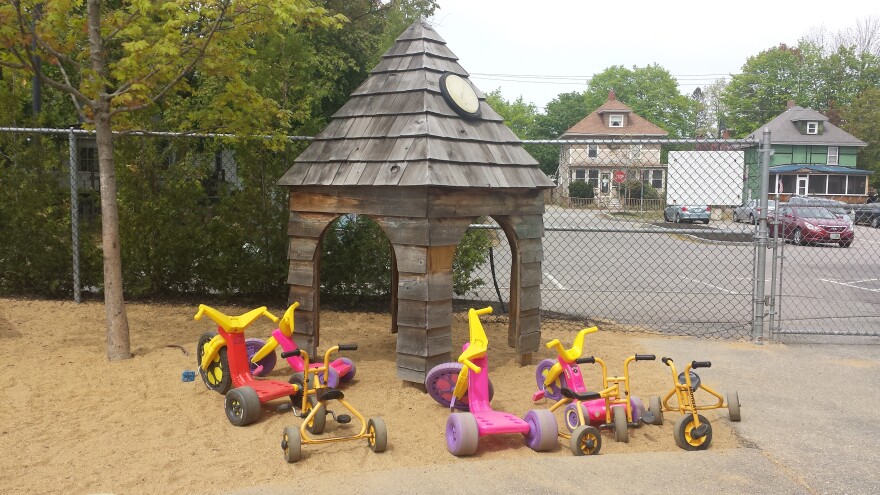Finding great day care can be hard. Sometimes finding any day care can be hard. Just ask Meghan Hoye of Merrimack, who tried everything to find a place for her three kids.
"They were all [age] four, two and a newborn," Hoye remembers. "There was a time where I was looking for day care at the point they were all under school age, below first grade. And there was no way I could afford it, period."
Hoye runs a business that retrofits buildings for energy efficiency. At first, she and her husband relied on their parents to look after the children, but they weren’t always available for full-time care. Then Hoye started working afternoons and evenings, so she could be home with the kids while her husband was on the job, but they both ended up exhausted. Eventually she found a relatively affordable center, but the kids hated it.

"When I picked them up they were as sad as when I dropped them off," Hoye says. "I said, this isn’t working."
New Hampshire has higher than average costs for child care, especially when it comes to young children. Those costs can pose big burdens for families. Kristin Smith of the Carsey School of Public Policy at the University of New Hampshire says rising child care costs over the last decade have hit low-income families particularly hard. "Low income families pay about 23 percent of their total family incomes on child care," Smith says, "which is significantly more than families at or above 200 percent of poverty, who paid 9 percent of their total family income on child care."
In Hoye’s case, once she found a good program at the local YMCA, it ended up costing 37 percent of the family’s income.
And cost isn’t the only hurdle low-income families have to overcome. Access is a problem, too, especially in more rural parts of the state. Kristin Smith says those in many lower-paying sectors, like retail, have irregular or unpredictable work schedules.
"Those families may rely on other family members," Smith says. "They may have other types of child care they can call on, on a short notice. But they may be not having the quality child care they would have if their child was in the same regular child care arrangement, which we know that that’s good for children in terms of child development and school readiness."
It'll either be a sturdy or a fragile foundation

The costs of child care can pose big burdens for families – and they can have big effects on kids.
New Hampshire’s child care system can be hard to measure, because it tends to be more decentralized than other states. And early education takes many forms, including child care centers and preschools, home-based providers, and kids who stay at home with parents or relatives.
What we do know, though, reveals something called a preschool poverty gap: Education Week magazine’s Research Center found overall preschool enrollment in New Hampshire was higher than in most states. But while 60 percent of families earning $100,000 a year or more send their 3 and 4 year olds to preschool programs, that number was only 40 percent for families with a household income of $20,000 or below.
In this preschool participation gap between high-income and low-income families, New Hampshire ranks 31st among states.
And that concerns Jackie Cowell of Early Learning New Hampshire, which provides training for child care providers. She says research on child brain development shows child care is much more than an economic support for working parents.
"The brain architecture is really built from the bottom up," Cowell says. "It’s like a house where the opportunities you give the children growing up is like a foundation. It’ll either be a sturdy or a fragile foundation, depending on those experiences that the young child will have in their first five years of life. So everything is going to be built on top – the learning, the behavior, the health - like a house."
And, Cowell says, you can see the effects of a consistent, high-quality child care experience throughout a child’s life.
"They’ll enter school ready to succeed, but they’ll also be more likely to graduate, more likely to have terrific income when they do graduate from college," Cowell adds. "They’ll be more productive members of society. So there’s lots of studies that there’s short-term benefit, like you mentioned the parents can work, but they enter school better and they’ll do much better as citizens later on."
The better child care centers in the state also tend to be licensed. But that means they’re more expensive to run. Business New Hampshire magazine found a 22 percent drop in the number of licensed child care programs in the state from 2002 to 2015. And Cowell says that means too many kids aren’t getting the best quality of care.
Education Week’s research center also found that while the national gap on preschool participation is widening slightly, New Hampshire’s gap has been getting smaller over time Jackie Cowell says the state has taken some steps to make it easier for some low-income families.
"We give assistance for families earning incomes up to a higher level than most states," Cowell explains, "because we know that when they did fall off the cliff, based on their incomes, some state assistance, they really couldn’t make ends meet. We were finding that they were spending something like 50 percent of their take-home pay on child care, once they went off of state assistance. So what’s the incentive to go off of state assistance?
"The good news is, we are finding families really are staying self-reliant. They’re going off assistance and staying off."
But Cowell says many who qualify for state child care assistance still can’t afford care – in part because lawmakers reduced the level of child care tuition assistance by about $8 million dollars, or 22 percent, to help close state budget gaps in 2010. New Hampshire is also the only state in New England not to receive a federal Race to the Top early learning grant, despite seeking one in 2013 to improve child care quality.
"Child care makes the world go round. Child care is community development."

One place that might point to a new model is a child care center based in an old mill building near Laconia’s downtown. Lakes Region Child Care Services operates this center and several others in the area, serving more than 400 children last year.

About 20 of those children are on the playground as Executive Director Marti Ilg shows me around. There are plenty of places for kids to roll, run and ride; appropriately for a center near Lake Winnipesaukee, there's a boat in the playground sand. There's room for both an ornamental garden, designed to attract butterflies, and a vegetable garden. "This program’s going to have a farmers market here once a week in the parking lot, for parents and local residents," Ilg explains. "[We're] very much tapped into that."
Lakes Region is tapped into a lot. Its food program means kids have fresh fruits and vegetables each day instead of chicken nuggets and tater tots. A partnership with Lakes Region Community College brings education students on site to work with staff. Centers are built close to affordable housing developments, so families can walk over.
Lakes Region has Licensed Plus certification from the state – fewer than 10 percent of centers have such accreditation – and a 2014 analysis found it had the second lowest tuition rates in the state for a Licensed or Licensed Plus center. Tuition isn’t the same for every family, but the center's average cost per child works out to $27 per day.
But Ilg says finding a way to have both high quality and affordability wasn’t easy. When the center lost state grant money in 2009 they realized they had to do things differently. They found community partners – nonprofit groups and businesses willing to invest. Volunteers help out and the centers buy supplies in bulk. The savings went back into programs and personnel.
Ilg points to similar collaborations in other parts of the state, like the Seacoast Early Learning Alliance, as evidence this model can work.
"Somebody years ago said to me that child care is sort of at the bottom of the early childhood totem pole," she says. "To me, child care makes the world go round. Child care is community development. Supporting parents’ ability to work… and we’re helping children develop optimally. We're helping the next generation of people who will live, learn and lead in New Hampshire. I just think it's pretty cool."
Ilg and other New Hampshire child care advocates say there needs to be coordination even beyond educators, social service agencies, nonprofits and employers. Helping to do that is Laura Milliken who directs the state’s early learning advisory council, Spark New Hampshire.
"Often extreme poverty goes with lack of access to health care, lack of access to high quality early childhood education," Milliken says. "And often families don’t have the support they need to give the support they need."
Both Milliken and Jackie Cowell of Early Learning New Hampshire say there’s been discussion of an increase to child care assistance in the next two year state budget. But Cowell says it probably won’t be on the level of the $3-5 million a year she says it would take to make high quality child care available across the state.
"We know that by giving them those early experiences, it's built into their bodies for better or for worse, that it's really our future workforce that we're talking about. 20 years seems like a long way away? It's not. It's not. So let's do it right."
For now, people like Meghan Hoye, the business owner in Merrimack, are going to have to make difficult decisions about child care. The youngest of Hoye’s three kids is finishing kindergarten, which means next school year’s child care will cost less. But she doesn’t expect the household budget to get much simpler anytime soon.
"I have heard from people I know and love who have said, well it is your choice. I can understand why someone may say, why are you taxing me for their choice to have children? And I think that’s valid as well," Hoye says.
"But it’s really not sustainable. We’re killing ourselves… we are all, as a group, not doing ourselves any favors."







